
- Licensed Maryland Home Inspector
- Licensed Maryland Home Improvement Contractor
- Accredited Lead Paint Risk Assessor
- Certified Residential Mold Inspector
Mold Inspection
Why Get a Mold Inspection?
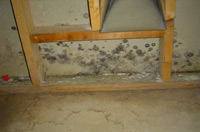
Buying a home or property?
Is there a musty smell in the building? Are there visible signs of water damage on the walls, ceiling, floor, anywhere? Has the home ever experienced a leaking basement, a roof leak, a plumbing leak, a sink or sewer back-up or overflow, a flood, or any other water problems?
Don't buy a home without a Mold Inspection!
The U. S. Department of Housing and Urban Developement encourages purchasers to obtain a Professional Mold Inspection prior to closing. (HUD-9548-E)
Visually see mold?
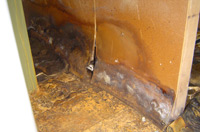
Have a mold inspection to check for additional mold and the source of the mold problem. Also have the mold tested to determine if it is toxic or allergenic.
Smells moldy or musty?
Again trust your instinct, if it smells like mold, it probably is. Many times mold grows behind walls or in attics, crawlspaces, or basements and is not readily visible. Have a mold inspection to check for mold and the source of the mold problem. If mold is found, have it tested to identify and determine if it is cosmetic, allergenic, pathogenic, or toxic.
Protect Your Family
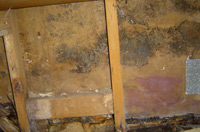
Some mold warning signs:
- Persistent Health Complaints (weeks to months)
- Persons feel better when away from the home or building
Some allergic symptoms:
- Sneezing, a runny and itchy nose, watering and itching of the eyes, nasal stuffiness, respiratory symptoms such as wheezing and coughing, increased asthma attacks or sudden onset of asthma
Some toxic symptoms:
- Memory loss, attention deficit/concentration problems, personality changes such as irritability or depression, neurological disorders such as tremors, tingling or burning of nose or mouth, chronic fatigue, dizziness, nausea/vomiting, bleeding in the lungs, suppression of the immune system, headache, flu-like symptoms, in coordination, muscle spasms and cramps.
What is a Mold Inspection?
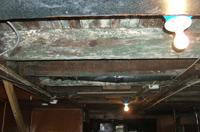
A good Inspection begins with a thorough visual inspection of the home by a Certified Mold Inspector. The process is similar to a home inspection only in that the whole house is inspected (exterior, interior, attic, crawl, and basement). Unlike a home inspection the focus is upon water intrusion and signs of microbial growth. The inspection is intense and thorough and may take longer than your home inspection, average 3-4 hours.
What results from a Mold Inspection?
Upon Visual Inspection, sources of water/moisture intrusion will be documented. If visual microbial growths are found, they will be documented and the source of water/moisture intrusion will be located. Sampling and testing of any found microbial growth will be recommended and documented. Test results will document if the microbial growth is mold and if the mold is cosmetic, allergenic, pathogenic, or toxic.
Why should a Mold Inspection be performed?
A Certified Mold Inspection should be performed for every real estate transaction. (This will be a requirement in the near future.) At a minimum a Mold Inspection should be performed when you see or smell mold. Trust your instincts. A basement is not supposed to smell musty. Recommend that your client (buyer or seller) get a Certified Mold Inspection from a Certified Mold Inspector. The buyer should enter into the real estate transaction with eyes wide open. The seller needs to correct problems and document the steps they took to correct them. A Certified Mold Inspection alleviates fear and worry.
Why a Certified Mold Inspector?
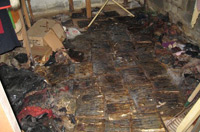
A license is not required for mold inspection, so anyone can claim to be a mold inspector. Certification is what distinguishes a professional. A Certified Mold Inspector is educated and trained for mold inspection and sampling. A Certified Mold Inspector will give you a thorough inspection focused on mold detection, average 3-4 hours. Home inspectors who add mold assessment for a nominal fee are not giving you a proper evaluation. How can a home inspector do a home inspection with mold in the same time it takes them to do a regular home inspection, average 2-3 hours. You want a certified professional performing your inspection/sampling and an accredited lab processing your samples. This is a health and safety issue. You want a Certified Mold Inspector whose only job is assessing the existing property as a non-biased neutral party, not an inspector/remediator trying to drum up sales for the remediation side of their business.
Where Mold Grows Easily
- Attics with roof leaks or inadequate ventilation
- Basements with dirt floors or water problems
- Behind and under showers, tubs, toilets, and bathroom walls
- Books, magazines, newspapers
- Carpeting and padding
- Ceilings [from roof leaks]
- Ceiling tiles
- Clothing
- Crawl spaces
- Drapes
- Drywall in ceilings and walls
- Garbage disposal
- Heating/cooling equipment & ducts
- Humidifiers & vaporizers [inside]
- Leather items
- Paint
- Paper, cardboard & other paper products
- Plants [house plants]
- Rags
- Upholstered furniture
- Walls [from siding, roof, & plumbing leaks]
- Wallpaper & behind wallpaper
- Wood products
Frequent Causes of Mold Growth
- Basement flooding and water intrusion
- Closeness to lake, river, or ocean
- Clothes dryer exhausting into walls, ceiling, or attic
- Construction defects & poor workmanship
- Crawl space
- Firewood stored indoors
- Flooding
- High indoor humidity [60%+]
- Humidifiers & vaporizers
- Inadequate ventilation
- Indoor plants
- Lot grading downward to home
- Overflow from tubs, showers, sinks, & toilets
- Landscaping mistakes like mulch & plant glut
- Leaky roof
- Sewage pipe leaks
- Siding water leak
- Venting inadequacies in kitchen & bathrooms
- Water supply pipe leaks
Thermal Imaging
Moisture and Mold Inspection
Thermal imaging cameras have many uses for inspecting homes. Thermal cameras are excellent at evaluating a home for moisture intrusion. When moisture is trapped behind a wall or ceiling and it is viewed with a thermal camera evidence of that moisture will show up due to the evaporation process of water. When water evaporates and turns from a liquid to a gas, this causes a temperature change to take place. This temperature change shows up on the surface of the wall or ceiling. This temperature difference is what makes it possible to see with a thermal camera. This alone is not confirmation that there is moisture present. At this time further investigation is necessary. Either moisture meter, boroscope or if possible open a section of the area of concern.
Structural Scans
By using a Thermal Camera and making sure that the interior temperature is approximately 20 degrees different from the exterior temperature the structure of a property can be viewed. Due to the difference in conductivity the framing structure will be a slightly different temperature then the wall cavity. This will allow the framing members to be viewed. This will show up omitted members and areas of concern. We have used this technique in conjunction with a certified engineer to view a project's structure when a contractor neglected to get the necessary framing and insulation inspections prior to closing the walls with drywall. The building inspector gave the client a choice of tearing out all the drywall so he could then do the proper inspections or having a structural engineer certify that the structure is sounds and properly insulated. The thermal camera made short work of evaluating the structure.
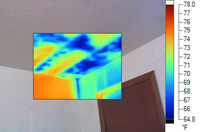 |
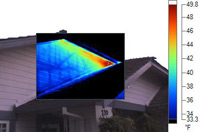 |
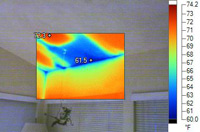 |
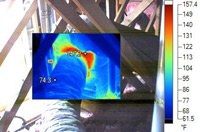 |
